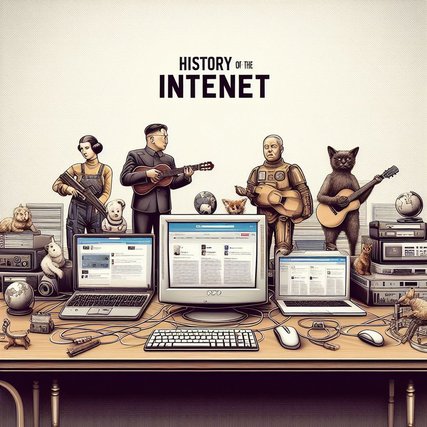History of the Internet
Like many major technological developments, the Internet has its origins in the military. During the Cold War, the United States decided to develop a comprehensive network that could withstand a nuclear strike. So it had to be decentralized, and each of its sub-points had to be able to decide independently how the data was transmitted.
“Like many major technological developments, the Internet has its origins in the military. During the Cold War, the United States decided to develop a comprehensive network that could withstand a nuclear strike. So it had to be decentralized, and each of its sub-points had to be able to decide independently how the data was transmitted.
In 1969 the time had come: four universities had joined forces to form the first network and communicated using a common protocol. The first word transmitted was "LOGIN". The "L" and the "O" worked perfectly and the network collapsed on the "G". This moment is considered the birth of the Internet, but no one could have predicted it back then. Success only comes much later. The second big step was the introduction of the TCP and IP protocols. Only since 1974 has it been possible to transmit data securely and efficiently over a large network. The first killer application was already in 1971. The email (yes, it is spelled correctly according to Duden) was invented and began its triumphant march without spam. Today over 90% of emails are spam, but that's just by the way.
Not much happened for the next 17 years. The Internet grew, but was only used by scientists who loved working on the command line. There were no ergonomics or graphical interfaces and searches were done via Archie or Gopher, Google and Yahoo were unknown. It wasn't until 1991 that Tim Berners-Lee at Cern had the idea of transferring data graphically and the World Wide Web was invented. From then on things progressed really quickly.
The Mosaic browser then became Netscape and then Mozilla. Microsoft missed the Internet (or should we write the WWW) and tried to counter with Internet Explorer. Which succeeded, but then Google came along and Microsoft was second again. The WWW then became commercial. Companies like AOL and Yahoo became giants, file-sharing platforms like Napster came (and went) and Mercedes and the small "mom and pop shop" were now on the Internet.
Notice
If you want to know what websites looked like back then, you can see for yourself. You can jump back in time using the Wayback function at the URL archive.org. Make a comparison and look at the FH Lübeck website (www.fh-luebeck.de) today and in 1996. Simply enter the URL of the FH Lübeck at archive.org, select the year 1996 and a date and you'll go back to the beginning." [4]
[4] Fit on the Internet, ocmk.oncampus.de, as of January 16, 2017, 12:05 p.m


